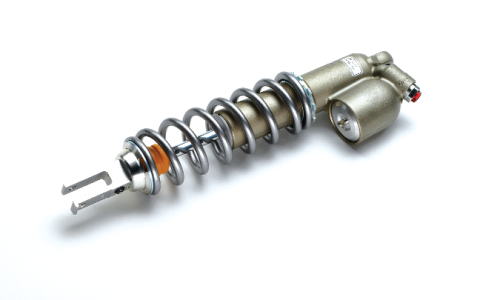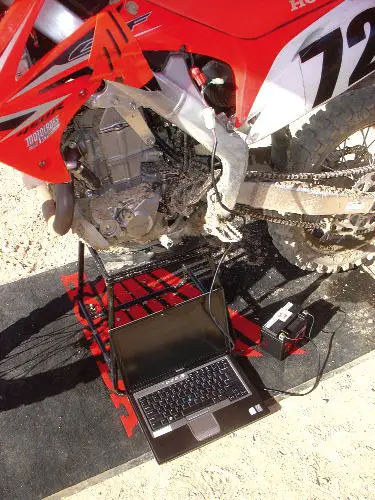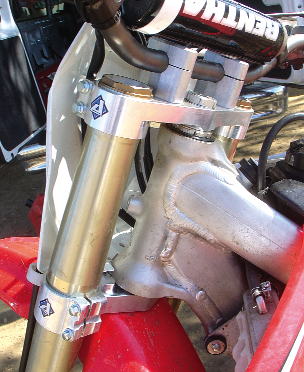10 BEST MODS FOR THE 2009 HONDA CRF450: Where We’d Spend Our Money…If It Was Your Money (And It Most Likely Is)
510 BEST MODS FOR THE 2009 HONDA CRF450:
WHERE WE’D SPEND OUR MONEY, IF IT WAS YOUR MONEY
HOW TO FIX THE FORKS

One of the big disappointments of the 2009 CRF450 setup is the stock Kayaba fork springs. The 0.46kg/mm springs are too soft. Not just too soft in terms of handling jumps and bumps, but the slight spring rate allows the chassis to shift its weight too far forward. The resulting stinkbug stance causes the chassis to ride low through bumps, dive under braking and oversteer in corners. And, as always, soft forks feel stiff. Step one is to replace the stock fork springs with stiffer 0.48kg/mm springs. Step two is to determine whether you feel there is enough mid-stroke compression damping. If not, you will need to have the forks revalved. We revalved our forks.
HOW TO FIX THE SHOCK WITH A LONGER LINK

MXA’s only complaint about the shock was a corollary to the soft forks?in that to get the bike balanced we had to run a lot more race sag than normal (often as much a 120mm). This is not a good idea. Once we stiffened the forks by adding 0.48kg/mm springs, we set the sag at 100mm, but the rear of the bike still felt very high. The quickest solution was to install a 146mm Pro Circuit shock linkage (www.procircuit.com) or Factory Connection linkage (www.factoryconnection.com). It replaces the stock 144mm linkage. It lowers the rear of the bike by 10mm to help flatten out the bike’s attitude. This was a very good mod, not just for the shock, but for the bike’s handling. As a side note to this mod, some shock companies will shorten the stock Honda shock by 3mm when revalving. This also lowers the rear of the CRF450.
WHAT ABOUT THE SHOCK SPRING?

As soft as Honda’s fork springs are, the 5.4kg/mm shock spring is very good for riders over 170 pounds (and it can handle riders up to and over 200 pounds). This is a good spec for a 450cc four-stroke, since most buyers are larger and more mature than the typical 250F owner. Smaller riders, however, will need to switch to a lighter rear spring rate. In additiona, if you have not changed the fork springs on your CRF450, try setting the race sag at 115mm with the high-speed compression turned two full turns out. These mods aren’t to improve the performance of the shock as much as to try to balance the front and rear of the CRF450.
WHAT IS THE BEST GEARING COMBINATION?

Most MXA test riders felt that the stock 13/48 gear ratio (3.692) had problems jumping the gap between second and third. The quick-and-easy fix was to install a 49-tooth rear sprocket to lower the gear ratios to 3.769. This worked well for most Beginner and Novice riders. Pro-level riders also felt that the stock 13/48 gearing was too tall, but that the 13/49 setup was too low for the speed they carried. If you are fast, go to a 14/52 gear combination (3.714). It splits the difference.
HOW HARD IS IT TO REPROGRAM THE FUEL INJECTOR?

If you’ve grown up with computers it is no problem to reprogram the Honda ignition. You will need an IBM compatible computer, 12-volt battery and Honda’s $350 PGM-FI tool. In the process of testing the 2009 CRF450, we reprogrammed the ECU over a dozen times. The Honda tool allows you to advance or retard the ignition and to alter the fuel flow through the injectors. Was it worth the effort? Not really. Although we could shift the powerband around, it was never as significant a change as just adding an exhaust pipe. Most of our attempts hurt more than they helped. In the end, the only new program that test riders liked (and it wasn’t universal) was to knock the bark off of the first millimeter of throttle twist (where the Honda is so jumpy that it is scary). We retarded the ignition at very small throttle openings from 2500 to 3500 rpm.
WHY THE RADIATOR SHROUDS NEED WORK

We had three problems with the 2009 CRF450’s radiator shrouds:
(1) We broke the shrouds on several occasions when the test riders’ knees hit against them. Honda says that they have thickened the plastic to help alleviate this problem, but there was no mention of how many of the thinner radiator wings were released.
WHAT TO DO IF YOUR BRAKES GET SPONGY

On both the CRF250 and CRF450, test riders reported that the brakes started to get spongy near the end of a 20-minute moto (and on one occasion two test riders shared the bike in back-to-back races, and the brakes faded significantly). The problem is the stock Honda disc guard. It blocks airflow to the rotor and causes heat-induced fade. The solution? Remove the brake disc guard. The problem? The left axle spacer is molded into the disc guard. We cut the plastic away from the spacer to eliminate the guard. If you think ahead, you can just press the spacer out or leave it in for resale value and order a Ride Engineering wheel spacer (www.ride-engineering.com). By the same token, we removed the under-slung disc guard from the rear brake also.
THINK ABOUT CHANGING THE WHEELBASE

For 2009, Honda moved the front wheel 17mm closer to the crankshaft (15mm in frame changes plus 2mm in triple clamp offset). At the same time, they moved the rear wheel 18mm farther away from the crank by lengthening the swingarm. That means that engine weight has been moved significantly forward. You have some control over this, based on where you set the rear axle. Most MXA test riders preferred to run a shorter chain and move the rear wheel as far forward in the axle slot as possible. If you do this, you will not only be moving the engine slightly rearward (in relationship to the two wheels), but will be lessening leverage on the shock (you may have to lighten low- and high-speed compression to compensate).
WHAT ABOUT DIFFERENT OFFSET TRIPLE CLAMPS?

Since the 2009 Honda CRF450 has some of the handling traits of the original 2002 CRF450, it was logical to assume that changing the offset on the ’09 might have the same beneficial outcome as it did six years ago. Over the last six years, Honda’s engineers have changed the stock triple clamp offset from 24mm (2002-2007) to 22mm (2008) to 20mm (2009). MXA had a set of 22mm triple clamps made (last year’s clamps will not accept the new Kayaba forks) to see if we could get better bite out of the front tire. The answer was no. Although the 22s turned in a little better, they were still very loose on the exit of the turn. They did nothing to eliminate the fast hand movements required to counter-steer the CRF450 in tight corners. There might be an offset number that helps, but it isn’t 22mm.
ARE EXHAUST PIPES WORTH THE MONEY?

No matter what anybody tells you about the 2009 Honda CRF450 powerband, it has a pure low-to-mid powerband. Although it will rev to 11,300 rpm, it is not a high rpm engine. It makes its best power from 6000 to 8200 rpm. It peaks at a rather average 50.25 horsepower at just over 8000 rpm. Through 8000 rpm to sign-off, it does not make any additional horsepower. It hangs. What the CRF450 needs more than anything else is some power from 8200 to 9500 rpm. We originally thought we could get this by reprogramming the ignition, but we eventually discovered that an aftermarket exhaust pipe was the best way to go. We tried five different exhausts and all of them carried the power up and beyond the stock CRF’s 8200-rpm peak. They were worth the money.






Comments are closed.